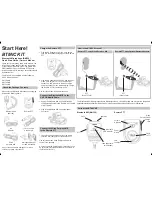
EN
1. Introduction
This manual contains essential information for the
operation and care of the product you have pur-
chased. Please read the instructions carefully and
completely before using the equipment. Please
keep this manual where it will be accessible at all
times to all current and future users.
Additional information, in particular concern-
ing available accessories and Neumann service
partners, can always be found on our website:
www.neumann.com. Information about service
partners can also be obtained by telephone:
+49 (0) 0 / 41 77 4 - 0.
The following related files are available in PDF
format in the Downloads section of our website
www.neumann.com:
Operation with Unbalanced or Center Tap
Grounded Inputs
Some Remarks on Microphone Maintenance
The Neumann online forum on our website en-
ables Neumann users worldwide to share their
experiences. Through its integrated archive func-
tion, the forum has developed into an extensive
knowledge pool.
2. Safety instructions
The microphone has the intended purpose of con-
verting acoustic signals into electrical signals.
Connect the microphone only to microphone in-
puts and devices which supply 48 V of phantom
power in accordance with IEC 6198.
Repairs and servicing are to be carried out only
by experienced, authorized service personnel.
Unauthorized opening or modification of the
equipment shall void the warranty.
Use the equipment only under the conditions
specified in the “Technical data” section. Allow
the equipment to adjust to the ambient tempera-
ture before switching it on. Do not operate the
equipment if it has been damaged during trans-
port.
Always run cables in such a way that there is no
risk of tripping over them.
Unless required for operation, ensure that liquids
and electrically conductive objects are kept at a
safe distance from the equipment and its connec-
tions.
•
•
EN
Do not use solvents or aggressive cleansers for
cleaning purposes.
Dispose of the equipment in accordance with the
regulations applicable to the respective country.
3. Brief description
The TLM 49 is a condenser studio microphone
with transformerless (TLM) circuit technology
and a cardioid directional characteristic.
The microphone is modelled after the M 49 and
the U 47, and shares their warm sound.
In the upper frequencies, the TLM 49 tends to-
ward a supercardioid directional characteristic,
exhibiting a smooth increase in presence above
kHz.
The microphone is optimized particularly for
vocals.
4. Scope of delivery
TLM 49 Set:
TLM 49 microphone
EA elastic suspension
Operating manual
5. Setup
Mounting the microphone
Attach the microphone to a stable, sturdy stand.
Use an elastic suspension, if necessary, for the
mechanical suppression of structure-borne noise.
For this purpose set the microphone into the inner
cage from above, and secure it to the inner cage
with the threaded nut. If required, use a wind-
screen or popscreen from our range of accesso-
ries in order to suppress wind or pop noise.
Connecting the microphone
Caution: An incorrect supply voltage can dam-
age the microphone!
Attach the microphone only to a power supply
unit, a microphone preamplifier, a mixing console
or other equipment which has phantom power
with 48 V (P 48), in accordance with IEC 6198.
Any P 48 power supply equipment can be used
which supplies at least mA per channel.
•
•
•
Caution: Very loud noise can damage loud-
speakers or your hearing!
Minimize the volume of connected playback and
recording equipment before connecting the mi-
crophone.
Using a suitable cable, connect the microphone
to the microphone input of the audio equipment
to be used for subsequent processing, or to the
designated P 48 power supply equipment. Infor-
mation concerning connector assignment can be
found in the “Technical data” section.
When connecting the cables, ensure that the con-
nectors are locked correctly. Run the cables in
such a way that there is no risk of tripping over
them.
Address the microphone from the side on which
the Neumann logo is located.
Gradually increase the volume of the connected
equipment.
Set the gain of the connected equipment so that
no distortion occurs at the highest sound pres-
sure level.
Suppressing noise interference
The frequency response of the TLM 49 extends
below 0 Hz. The microphone is of course corre-
spondingly sensitive to low-frequency interfer-
ence such as structure-borne noise and wind or
pop noise. Depending upon the situation, the use
of an elastic suspension, a windscreen and/or a
popscreen is therefore recommended.
Sound test
Simply speak into the microphone. Do not blow
into the microphone or subject it to pop noise,
since this can easily result in hazardous sound
pressure levels.
6. Shutdown and storage
Before switching off the microphone or discon-
necting the cables, reduce the volume of con-
nected equipment.
Only then should the phantom power be switched
off.
Disconnect the cables.
When disconnecting a cable, always pull only on
the connector and not on the cable itself.
Microphones which are not in use should not be
allowed to remain on the stand gathering dust. A
microphone which is unused for a prolonged pe-
riod should be stored under normal atmospheric
conditions, and should be protected from dust.
For this purpose, use a lint-free, air-permeable
dust cover or the original packaging of the micro-
phone.
7. Troubleshooting
Problem
▶
Possible causes
▶
Solution
Microphone
not operating
The phantom power supply voltage is not
switched on at the mixing console or at the
power supply equipment.
Check the corresponding channel settings.
The power supply equipment is not con-
nected to the power supply line or there is
no battery.
Check the connection to the power supply
line or check the battery of the power supply
equipment.
No signal
transmission
The microphone is not connected to the
correct microphone amplifier input of the
subsequent equipment.
Check the signal path.
If necessary, activate the appropriate input
on the corresponding channel of the mixing
console.
































